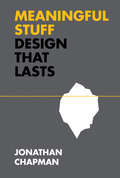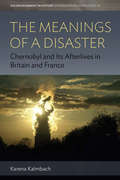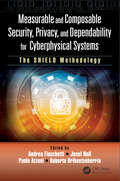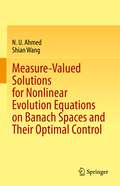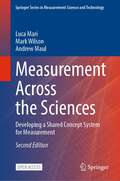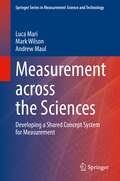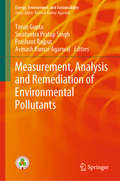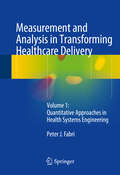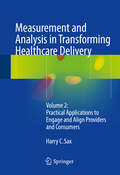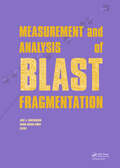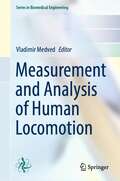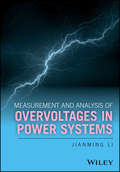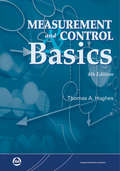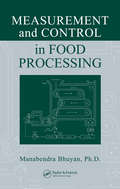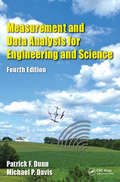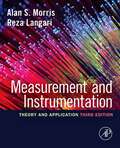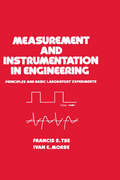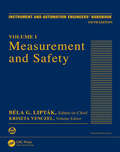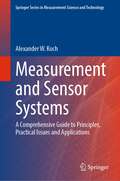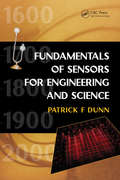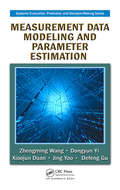- Table View
- List View
Meaningful Stuff: Design That Lasts (Design Thinking, Design Theory)
by Jonathan ChapmanAn argument for a design philosophy of better, not more.Never have we wanted, owned, and wasted so much stuff. Our consumptive path through modern life leaves a wake of social and ecological destruction--sneakers worn only once, bicycles barely even ridden, and forgotten smartphones languishing in drawers. By what perverse alchemy do our newest, coolest things so readily transform into meaningless junk? In Meaningful Stuff, Jonathan Chapman investigates why we throw away things that still work, and shows how we can design products, services, and systems that last. Obsolescence is an economically driven design decision--a plan to hasten a product's functional or psychological undesirability. Many electronic devices, for example, are intentionally impossible to dismantle for repair or recycling, their brief use-career proceeding inexorably to a landfill. A sustainable design specialist who serves as a consultant to global businesses and governmental organizations, Chapman calls for the decoupling of economic activity from mindless material consumption and shows how to do it.Chapman shares his vision for an "experience heavy, material light" design sensibility. This vital and timely new design philosophy reveals how meaning emerges from designed encounters between people and things, explores ways to increase the quality and longevity of our relationships with objects and the systems behind them, and ultimately demonstrates why design can--and must--lead the transition to a sustainable future.
The Meanings of a Disaster: Chernobyl and Its Afterlives in Britain and France (Environment in History: International Perspectives #20)
by Karena KalmbachThe disaster at the Chernobyl nuclear power plant was an event of obviously transnational significance—not only in the airborne particulates it deposited across the Northern hemisphere, but in the political and social repercussions it set off well beyond the Soviet bloc. Focusing on the cases of Great Britain and France, this innovative study explores the discourses and narratives that arose in the wake of the incident among both state and nonstate actors. It gives a thorough account of the stereotypes, framings, and “othering” strategies that shaped Western European nations’ responses to the disaster, and of their efforts to come to terms with its long-term consequences up to the present day.
Means of Access for Enclosed Spaces: Guidance for Marine Professionals (Synthesis Lectures on Ocean Systems Engineering)
by Alexander Arnfinn OlsenThis book provides critical information relating to the design and construction of means of access onboard marine vessels and platforms, including ladders, walkways and ramps, hatches, and alternative access points. Uniquely, this book highlights the importance of considering human factors and ergonomics in engineering design. In support of the Statutory and IACS guidance, this book has been written to provide graphical illustrations and additional textual clarification of the means of access requirements. The goal is to improve the comprehension and application of the Statutory and IACS guidance. Conceptually, this text presents two levels of means of access guidance. The first provides the base criteria to meet the IMO requirements. The second, and preferred, level of guidance incorporates the application of current ergonomics practices to the means of access requirements. The application of ergonomics to the means of access requirements will enhance levels of safety as well as quality of work by providing appropriate access for survey, inspection and maintenance activities for tanks and holds.
Measurable and Composable Security, Privacy, and Dependability for Cyberphysical Systems: The SHIELD Methodology
by Andrea Fiaschetti Josef Noll Paolo Azzoni Roberto UribeetxeberriaWith a business baseline focused on the impact of embedded systems in the years ahead, the book investigates the Security, Privacy and Dependability (SPD) requirements raised from existing and future IoT, Cyber-Physical and M2M systems. It proposes a new approach to embedded systems SPD, the SHIELD philosophy, that relies on an overlay approach to SPD, on a methodology for composable SPD, on the use of semantics, and on the design of embedded systems with built-in SPD. The book explores new ground and illustrates the development of approximately forty prototypes capable of managing and enhancing SPD, including secure boot, trusted execution environments, adaptable radio interfaces, and different implementations of the middleware for measuring and composing SPD.
Measure-Valued Solutions for Nonlinear Evolution Equations on Banach Spaces and Their Optimal Control
by N. U. Ahmed Shian WangThis book offers the first comprehensive presentation of measure-valued solutions for nonlinear deterministic and stochastic evolution equations on infinite dimensional Banach spaces. Unlike traditional solutions, measure-valued solutions allow for a much broader class of abstract evolution equations to be addressed, providing a broader approach.The book presents extensive results on the existence of measure-valued solutions for differential equations that have no solutions in the usual sense. It covers a range of topics, including evolution equations with continuous/discontinuous vector fields, neutral evolution equations subject to vector measures as impulsive forces, stochastic evolution equations, and optimal control of evolution equations. The optimal control problems considered cover the existence of solutions, necessary conditions of optimality, and more, significantly complementing the existing literature.This book will be of great interest to researchers in functional analysis, partial differential equations, dynamic systems and their optimal control, and their applications, advancing previous research and providing a foundation for further exploration of the field.
Measurement Across the Sciences: Developing a Shared Concept System for Measurement (Springer Series in Measurement Science and Technology)
by Luca Mari Mark Wilson Andrew MaulThis open access book proposes a conceptual framework for understanding measurement across a broad range of scientific fields and areas of application, such as physics, engineering, education, and psychology. It addresses contemporary issues and controversies within measurement in light of the framework, including operationalism, definitional uncertainty, and the relations between measurement and computation, and describes how the framework, operating as a shared concept system, supports understanding measurement’s work in different domains, using examples in the physical and human sciences.This revised and expanded second edition features a new analysis of the analogies and the differences between the error/uncertainty-related approach adopted in physical measurement and the validity-related approach adopted in psychosocial measurement. In addition, it provides a better analysis and presentation of measurement scales, in particular about their relations with quantity units, and introduces the measurand identification/definition as a part of the "Hexagon Framework" along with new examples from the physical and psychosocial sciences. Researchers and academics across a wide range of disciplines including biological, physical, social, and behavioral scientists, as well as specialists in measurement and philosophy appreciate the work’s fresh and provocative approach to the field at a time when sound measurements of complex scientific systems are increasingly essential to solving critical global problems.
Measurement across the Sciences: Developing a Shared Concept System for Measurement (Springer Series in Measurement Science and Technology)
by Mark Wilson Luca Mari Andrew MaulThis book proposes a conceptual framework for understanding measurement across a broad range of scientific fields and areas of application, such as physics, engineering, education, and psychology. The authors, who themselves span these disciplines, argue that the justification of the public trust attributed to measurement results can in principle apply identically to both physical and psychosocial properties. They further argue that the lack of a common conceptualization of measurement hampers interdisciplinary communication and limits the ability to share knowledge. They advance their views by first surveying the conceptual history of the philosophy of measurement and arguing that classical, operationalist and representational perspectives on measurement each make important contributions but also each have important shortcomings. A synthesis is then offered as the foundation for a new conceptual framework. The authors describe how the framework, which operates as a shared concept system, supports understanding measurement’s work in different domains, using examples in the physical and human sciences. They consider connections and consequences with respect to causality, objectivity, and intersubjectivity, among other topics, and how measurement science concepts and issues are construed across these disciplines and settings. They also address contemporary issues and controversies within measurement in the light of the framework, including operationalism, definitional uncertainty, and the relations between measurement and computation. The book concludes with a justification for the basic claim that measurement is an empirical and informational process that produces explicitly justifiable information. Researchers and academics across a wide range of disciplines including biological, physical, social and behavioral scientists, as well as specialists in measurement and philosophy will appreciate the work’s fresh and provocative approach to the field at a time when sound measurements of complex scientific systems are increasingly essential to solving critical global problems.
Measurement, Analysis and Remediation of Environmental Pollutants (Energy, Environment, and Sustainability)
by Tarun Gupta Swatantra Pratap Singh Prashant Rajput Avinash Kumar AgarwalThis book discusses contamination of water, air, and soil media. The book covers health effects of such contamination and discusses remedial measures to improve the situation. Contributions by experts provide a comprehensive discussion on the latest developments in the detection and analysis of contaminants, enabling researchers to understand the evolution of these pollutants in real time and develop more accurate source apportionment of these pollutants. The contents of this book will be of interest to researchers, professionals, and policy makers alike.
Measurement and Analysis in Transforming Healthcare Delivery
by Peter J. FabriThis volume provides the important concepts necessary for a physician to participate in a reengineering process, develop decision-making skills based on probability and logic rather than "rules," and to measure and analyze meaningful outcomes of care delivery. This approach has been developed over ten years in a medical student-based program and has been enthusiastically embraced by medical students without backgrounds in engineering or statistics. More specifically, this text will introduce physicians to relevant and available computer software, combined with an in depth knowledge of measurement, variation, and uncertainty. It provides a basis for the transformation of data into information, information into knowledge, and knowledge into wisdom. The first quarter of the book will address understanding and visualizing data, using statistical and graphic analysis. The next quarter addresses the fundamentals of applied statistics, and the application of conditional probability to clinical decision making. The next quarter addresses the four "cornerstones" of modern analytics: regression, classification, association analysis, and clustering. The final section addresses the identification of outliers and their importance in understanding, the assessment of cause and effect and the limitations associated with retrospective data analysis. This toolbox will prepare the interested physician to actively engage in the identification of problem areas, the design of process-based solutions, and the continuous assessment of outcomes of clinical practice. Armed with this toolbox, the reader will be "prepared to make a difference" in the rapidly changing world of healthcare delivery. Measurement and Analysis in Transforming Healthcare Delivery is an excellent resource for general practitioners, health administrators, and all medical professionals interacting with healthcare delivery.
Measurement and Analysis in Transforming Healthcare Delivery
by Harry C. SaxThis volume is complementary to Volume 1: Quantitative Approaches in Health Systems Engineering which provides in-depth analysis of the statistical and quantitative aspects of Health Systems Engineering. Volume 2: Practical Applications to Engage and Align Providers and Consumers builds upon these concepts with the integration of additional economic, performance and quality measures. Stressing the importance of changes in the economics of health care financing, it will serve as a resource for not only leaders of organizations, but also providers who will be practicing a different type of medicine from that of which they were trained. After defining the challenges, the authors will quantify and define funds flows and various margins necessary for viability, how providers will be measured and rewarded for quality, and the importance of accurate dashboard of physician performance. Types of payment systems, including capitation, ACOs, risk contracts, and hybrid forms of fee for service will be defined and their relative advantages discussed. Lessons from other countries that provide high quality care at a lower cost will be examined for applicability to our challenges. Finally, experts in leadership will focus on influencing behavior to achieve results while remembering that healthcare is about the patient. This textbook will serve as a useful resource for clinicians, healthcare executives, governmental agencies, and emerging leaders in organizations.
Measurement and Analysis of Blast Fragmentation
by José A. Sanchidrián Ashok Kumar SinghFragmentation characteristics influence mucking productivity, crusher throughput and energy consumption, plant efficiency, yield and recovery, or the price itself of the end product in the case of industrial minerals and aggregates. Reliable, quantitative measurements of fragment sizes are instrumental in controlling and optimizing the blasting res
Measurement and Analysis of Human Locomotion (Series in Biomedical Engineering)
by Vladimir MedvedThis book addresses instruments, methodologies and diagnostic methods used to evaluate and diagnose human movement, locomotion and physical status in general. Starting from historical perspective, the idea of understanding human locomotion by applying technical measurement devices and incorporating measurement data into physical representation of gross body movement is presented and explained, an approach known as inverse dynamics. With this approach as a kind of umbrella concept, components of measurement systems including relevant signal and data processing methods are described. Modern instruments to capture body movement by measuring its kinematics, kinetics and surface electromyography (sEMG) are thus described; all systems being used dominantly—if not exclusively—in a movement analysis laboratory setting. Focusing mainly on human posture and gait, but including also examples of movement patterns from selected kinesiological and sports activities, the book attempts to present essentials of biomechanics and biomedical engineering approach to this subject matter. It illustrates how data collected and elaborated by modern engineering technology can complement traditional expert knowledge of a kinesiologist or a medical doctor. The book is applicable in the fields of sports, physical activities, as well as in medical diagnostics and rehabilitation. The examples of this book’s practical application might be in evaluation of efficiency of human gait, in evaluation of skeletal muscle fatigue in physical exercise, in biomechanical diagnostics of traumatological conditions requiring orthopaedic treatment and the like. This book can also be used in planning and executing research endeavours, particularly in a clinical context as a reference for various diagnostics procedures. It presents the lecture notes of a course carrying the same name within Medical Studies in English at the University of Zagreb for more than a decade.
Measurement and Analysis of Overvoltages in Power Systems
by Jianming LiMeasurement and Analysis of Overvoltages in Power Systems Jianming Li, Professor, State Grid Corporation, China A combination of theory and application, this book features practical tests and analytical techniques comprehensively with engineering practicality as its focus. Based on years of research and industry experience, the author introduces many scientific research methods such as overvoltage simulation studies, dynamic simulation experiment platform development and application, and overvoltage pattern recognition. Readers will get a good grounding in the various sources of overvoltages in power systems, methods in on-line measurements as well as explanations of overvoltage formation mechanisms and monitoring analysis methods. •Systematically examines sources, online measurements, analytical techniques, and simulations of overvoltages, with an emphasis on engineering practicality •Presents practical engineering examples analyzing overvoltages and improving system operation, based on field experiments and data analysis •Features overvoltage simulations and waveform analysis in transmission systems Measurement and Analysis of Overvoltages in Power Systems is intended as an all-in-one guide for engineers and researchers in power systems engineering. It can be used as a reference text for graduate students and lecturers of electrical engineering.
Measurement and Control Basics
by Thomas A. HughesIdeal for classroom use or self-study, this newly revised best-selling book has provided thousands of students, technicians, sales people, and others with a practical introduction to the technologies, systems, and strategies involved in industrial process control. The fourth edition takes the same proven intuitive approach of previous editions. Each chapter begins with basic definitions and mathematical concepts that allow readers to become well versed in the principles necessary to understand the variables that affect process control systems. New features in the fourth edition include improved coverage of analytical measurement and control, and the addition of sections on the international standard for PLC languages; process visualization; and personal computer-based control systems. The book also includes solutions to exercises that make it more suitable for self-study.
Measurement and Control in Food Processing
by Manabendra BhuyanDesigned to raise awareness of the current techniques of measurement and control, this book will aid in the design of instruments and control schemes, explain the applicability of these tools to enhance quality and productivity, and educate students preparing to enter the food industry. Divided into five major chapters, the book lays a solid foundation for understanding the role of transducers and controllers, covers the most recent developments and applications in measurement techniques, and explains non-traditional methods such as electronic noses, biosensors, fuzzy logic control, and microcomputer-based monitoring.
Measurement and Data Analysis for Engineering and Science (Engineering Ser.)
by Patrick F Dunn Michael P. DavisMeasurement and Data Analysis for Engineering and Science, Fourth Edition, provides up-to-date coverage of experimentation methods in science and engineering. This edition adds five new "concept chapters" to introduce major areas of experimentation generally before the topics are treated in detail, to make the text more accessible for undergraduate students. These feature Measurement System Components, Assessing Measurement System Performance, Setting Signal Sampling Conditions, Analyzing Experimental Results, and Reporting Experimental Results. More practical examples, case studies, and a variety of homework problems have been added; and MATLAB and Simulink resources have been updated.
Measurement and Instrumentation in Engineering: Principles and Basic Laboratory Experiments (Mechanical Engineering #67)
by Francis S. Tse Ivan E. MorsePresenting a mathematical basis for obtaining valid data, and basic concepts inmeasurement and instrumentation, this authoritative text is ideal for a one-semesterconcurrent or independent lecture/laboratory course.Strengthening students' grasp of the fundamentals with the most thorough, in-depthtreatment available, Measurement and Instrumentation in Engineeringdiscusses in detail basic methods of measurement, interaction between a transducer andits environment, arrangement of components in a system, and system dynamics ...describes current engineering practice and applications in terms of principles andphysical laws .. . enables students to identify and document the sources of noise andloading . .. furnishes basic laboratory experiments in sufficient detail to minimizeinstructional time ... and features more than 850 display equations, over 625 figures,and end-of-chapter problems.This impressive text, written by masters in the field, is the outstanding choice forupper-level undergraduate and beginning graduate-level courses in engineeringmeasurement and instrumentation in universities and four-year technical institutes formost departments.
Measurement and Modeling of Silicon Heterostructure Devices
by John D. CresslerWhen you see a nicely presented set of data, the natural response is: “How did they do that; what tricks did they use; and how can I do that for myself?” Alas, usually, you must simply keep wondering, since such tricks-of- the-trade are usually held close to the vest and rarely divulged. Shamefully ignored in the technical literature, measurement and modeling of high-speed semiconductor devices is a fine art. Robust measuring and modeling at the levels of performance found in modern SiGe devices requires extreme dexterity in the laboratory to obtain reliable data, and then a valid model to fit that data. Drawn from the comprehensive and well-reviewed Silicon Heterostructure Handbook, this volume focuses on measurement and modeling of high-speed silicon heterostructure devices. The chapter authors provide experience-based tricks-of-the-trade and the subtle nuances of measuring and modeling advanced devices, making this an important reference for the semiconductor industry. It includes easy-to-reference appendices covering topics such as the properties of silicon and germanium, the generalized Moll-Ross relations, the integral charge-control model, and sample SiGe HBT compact model parameters.
Measurement and Safety: Volume I
by Béla G. LiptákThis handbook is dedicated to the next generation of automation engineers working in the fields of measurement, control, and safety, describing the sensors and detectors used in the measurement of process variables.
Measurement and Sensor Systems: A Comprehensive Guide to Principles, Practical Issues and Applications (Springer Series in Measurement Science and Technology)
by Alexander W. KochThis book covers both the physical properties of sensors for converting physical quantities into digital data and the design of complex measurement and data analyzing systems. In respect thereof, a unique treatment of measurement and sensor systems is given from a physical point of view, wherein a focus is on innovative links between physics and engineering sciences.The acquisition of data by measurement systems equipped with appropriate sensors is a fundamental activity in science and industry. In a connected world, the field of measurement and sensor systems can be regarded as an enabling technology for other fields of research and development, e.g., for electronics, chemistry, biology, and environmental monitoring.The book is divided into eleven chapters, each chapter starting with a discussion of measurement systems based on the relevant sensor concept followed by an in-depth description of the data processing and analysis procedures. After an introduction presenting fundamentals of measurement systems, digital measurement systems are addressed in detail. Then, operational amplifiers and measurement bridges as well as measurement signal processing methods are presented. After discussing transducers based on ohmic, capacitive, and inductive effects, temperature measurement systems are described. A separate chapter is devoted to optical measurement and sensor systems which represent a field of increasing importance.
Measurement, Data Analysis, and Sensor Fundamentals for Engineering and Science
by Patrick F. DunnA combination of two texts authored by Patrick Dunn, this set covers sensor technology as well as basic measurement and data analysis subjects, a combination not covered together in other references. Written for junior-level mechanical and aerospace engineering students, the topic coverage allows for flexible approaches to using the combination book in courses. MATLAB® applications are included in all sections of the combination, and concise, applied coverage of sensor technology is offered. Numerous chapter examples and problems are included, with complete solutions available.
Measurement Data Modeling and Parameter Estimation (Systems Evaluation, Prediction, and Decision-Making)
by Zhengming Wang Dongyun Yi Xiaojun Duan Jing Yao Defeng GuThis book discusses the theories, methods, and application techniques of the measurement data mathematical modeling and parameter estimation. It seeks to build a bridge between mathematical theory and engineering practice in the measurement data processing field so theoretical researchers and technical engineers can communicate. It is organized with abundant materials, such as illustrations, tables, examples, and exercises. The authors create examples to apply mathematical theory innovatively to measurement and control engineering. Not only does this reference provide theoretical knowledge, it provides information on first hand experiences.
Measurement for the Sea: Supporting the Marine Environment and the Blue Economy (Springer Series in Measurement Science and Technology)
by Giovanni Battista Rossi Pasquale Daponte Vincenzo PiscopoIn the history of humankind, the sea has always played a key role as a privileged medium for communication, commerce and contact among population centers. It constitutes an essential ecosystem, and an invaluable reservoir and source of food for all living beings. Therefore, its heath is a critical challenge for the survival of all humanity, particularly as one the most important environmental components targeted by global warming. Measuring and monitoring techniques are key tools for managing the marine environment and for supporting the Blue Economy. With this perspective, a series of annual international events, entitled Metrology for the Sea (MetroSea for short) was begun in 2017. Their increasing success inspired this book, which provides an anthology of tutorials dealing with a representative selection of topics of concern to a broad readership. The book covers two broad application areas, marine hydrography and meteorology, and then deals with instrumentation for measurement at sea. Typical metrological issues such as calibration and traceability, are considered, for both physical and chemical quantities. Key techniques, such as underwater acoustic investigation, remote sensing, measurement of waves and monitoring networks, are treated alongside marine geology and the monitoring of animal species. Economic and legal aspects of metrology for navigation are also discussed. Such an unparalleled wide vision of measurement for the sea will be of interest to a broad audience of scientists, engineers, economists, and their students.
Measurement in Medicine
by Henrica C. W. de Vet Caroline B. Terwee Lidwine B. Mokkink Dirk L. KnolThe success of the Apgar score demonstrates the astounding power of an appropriate clinical instrument. This down-to-earth book provides practical advice, underpinned by theoretical principles, on developing and evaluating measurement instruments in all fields of medicine. It equips you to choose the most appropriate instrument for specific purposes. The book covers measurement theories, methods and criteria for evaluating and selecting instruments. It provides methods to assess measurement properties, such as reliability, validity and responsiveness, and interpret the results. Worked examples and end-of-chapter assignments use real data and well-known instruments to build your skills at implementation and interpretation through hands-on analysis of real-life cases. All data and solutions are available online. This is a perfect course book for students and a perfect companion for professionals/researchers in the medical and health sciences who care about the quality and meaning of the measurements they perform.
